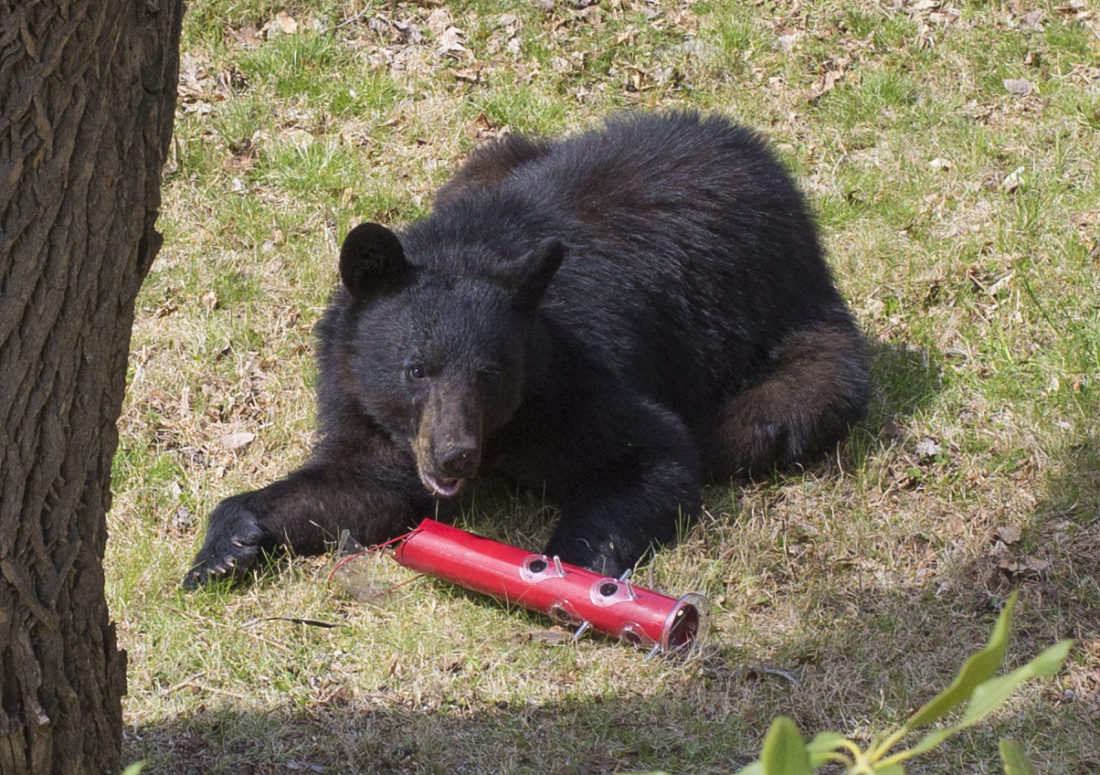Press release from the North Carolina Wildlife Resources Commission:
Over the last few weeks, biologists with the N.C. Wildlife Resources Commission have experienced an uptick in calls from people who are seeing bears in neighborhoods. This is the time of year when bears are on the move as they search for natural food sources and yearling bears are looking for a new home.
In almost all instances, biologists advise callers to be “BearWise” if they are seeing bear activity. Being BearWise means living responsibly with bears by abiding by six BearWise Basics, the first and most important of which is to never feed or approach a bear — either intentionally or unintentionally. Feeding bears trains them to look for food by approaching homes and people. Bears are particularly attracted to bird seed, hummingbird feeders, garbage and other human-associated foods, like pet food. Bears may defend themselves if a person gets too close, so do not risk your safety or theirs.
“If you see a bear in your yard, your neighborhood, in the woods, wherever, don’t try to feed or approach the bear — we can’t stress this enough,” said Colleen Olfenbuttel, the agency’s black bear biologist. “Approaching or cornering a bear can unnerve it, perhaps causing it to act defensively.”
If left alone, most bears that wander into a neighborhood will quickly retreat to their natural habitat, particularly if no food source is around. While bears are naturally quite wary of people, Olfenbuttel says it is important to be cautious and follow the remaining five BearWise Basics to prevent potential conflicts and live responsibly with bears.
- Secure food, garbage and recycling. Food and food odors can attract bears from over a mile away, so don’t reward them with easily available food or garbage. Store bags of trash inside cans in a garage, shed or other secure area; or use garbage cans or trash containers with a secure latching system or that are bear resistant. Place trash outside as late as possible on the morning of trash pick-up — not the night before.
- Remove bird feeders when bears are active. Birdseed, other grains and hummingbird feeders have high calorie content making them very attractive to bears.
- Never leave pet food outdoors. Feed outdoor pets portion sizes that will be completely eaten during each meal and remove the empty food bowl.
- Clean and store grills. Make sure all grease, fat and food particles are removed, even from the drip tray, after each use. Once the grill is clean, store it in a bear-resistant location, like a garage or shed.
- Alert neighbors to bear activity. Seen bears in the area or evidence of bear activity? Tell your neighbors and share info on how to avoid bear conflicts. Bears have adapted to living near people; now it’s up to people to adapt to living near bears.
In addition to removing food attractants, residents can:
- Install electric fencing, which will protect bee hives, dumpsters, gardens, compost piles and other potential food sources. Find out how to install them at: bearwise.org/bear-safety-tips/keep-bears-out/
- Consider using a bear-resistant trash container or altering your current container to become bear-resistant if allowed by your sanitation provider.
- Talk to neighbors and consider becoming a certified BearWise community. BearWise communities commit to co-existing responsibly with bears, securing all potential food sources, and knowing when and how to report bear activity. Members of BearWise-certified communities work together to prevent conflicts between bears and humans by following the six BearWise Basics. Find out more on how to become a BearWise community.
When Commission staff receive a report of a bear in an area, they assess the situation to determine if the bear poses a threat to public safety or property. They also assess if people are habituating the bear by purposely or incidentally feeding the bear. In almost all cases, the Commission advises that the best option to keep bears wild and to assure human safety is to remove attractants in the area.
The agency does not trap and relocate bears. If a bear is a threat to public safety, moving the bear only moves the problem to someone else’s community rather than solving the underlying issue.
“Human activities and behavior are usually the cause of the problem and the best solution is to implement the BearWise Basics,” Olfenbuttel said. “There are no remote places to move bears and relocation can be treacherous for the bear, as they are unfamiliar with the new place and where the food resources are. They will often try to return to where they were originally captured, encountering a variety of hazards such as dominant bears, human development, and major roadways in the process.”
For more information about living responsibly with black bears, visit bearwise.org. For more information about black bears in North Carolina, visit ncwildlife.org/bear. For questions regarding bears and other human-wildlife interactions, call the Commission’s N.C. Wildlife Helpline toll-free at 866-318-2401 to leave a voicemail during operating hours or email the Helpline at wildlifehelpline@ncwildlife.org. The call center is currently open Monday through Friday (excluding holidays) from 8 a.m. to 2 p.m.




Before you comment
The comments section is here to provide a platform for civil dialogue on the issues we face together as a local community. Xpress is committed to offering this platform for all voices, but when the tone of the discussion gets nasty or strays off topic, we believe many people choose not to participate. Xpress editors are determined to moderate comments to ensure a constructive interchange is maintained. All comments judged not to be in keeping with the spirit of civil discourse will be removed and repeat violators will be banned. See here for our terms of service. Thank you for being part of this effort to promote respectful discussion.